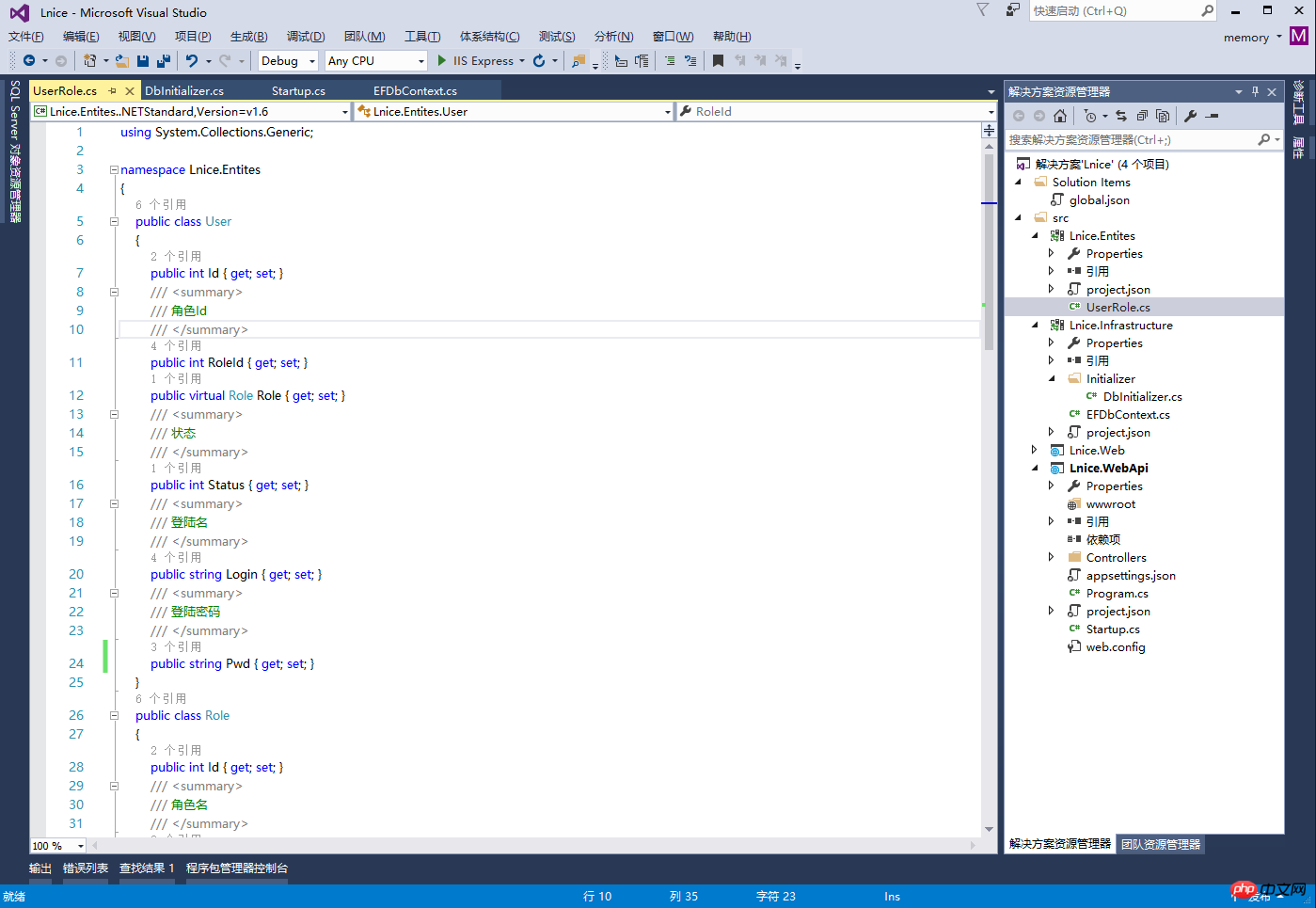
1, first download the corresponding Microsoft official .net core sdk and run according to personal needstime(https://www.microsoft.com/net/download/core)
2, create a asp.net Core project

public class User
{
public int Id { get; set; }
/// <summary>
/// 角色Id
/// </summary>
public int RoleId { get; set; }
public virtual Role Role { get; set; }
/// <summary>
/// 状态
/// </summary>
public int Status { get; set; }
/// <summary>
/// 登陆名
/// </summary>
public string Login { get; set; }
/// <summary>
/// 登陆密码
/// </summary>
public string Pwd { get; set; }
} public class Role
{
public int Id { get; set; }
/// <summary>
/// 角色名
/// </summary>
public string Name { get; set; }
/// <summary>
/// 一个角色的多个用户
/// </summary>
public virtual ICollection<User> Users { get; set; }
} public class EFDbContext: DbContext
{
public EFDbContext(DbContextOptions<EFDbContext> options) : base(options)
{ }
public DbSet<Role> Roles { get; set; }
public DbSet<User> Users { get; set; }
protected override void OnModelCreating(ModelBuilder modelBuilder)
{
Role(modelBuilder);
User(modelBuilder);
}
private void User(ModelBuilder modelBuilder)
{
var userBuilder = modelBuilder.Entity<User>().ToTable("User");
// Properties
userBuilder.Property(t => t.Id).ValueGeneratedOnAdd();
userBuilder.Property(t => t.RoleId).IsRequired();
userBuilder.Property(t => t.Status).IsRequired();
userBuilder.Property(t => t.Login).IsRequired().HasMaxLength(30);
userBuilder.Property(t => t.Pwd).IsRequired().HasMaxLength(60);
// Primary Key
userBuilder.HasKey(t => t.Id);
// Index
userBuilder.HasIndex(t => t.Login);
// Relationships
userBuilder.HasOne(t => t.Role).WithMany(t => t.Users).HasForeignKey(t => t.RoleId);
}
private void Role(ModelBuilder modelBuilder)
{
var roleBuilder = modelBuilder.Entity<Role>().ToTable("Role");
// Properties
roleBuilder.Property(t => t.Id).ValueGeneratedOnAdd();
roleBuilder.Property(t => t.Name).IsRequired().HasMaxLength(30);
// Primary Key
roleBuilder.HasKey(t => t.Id);
}
}##
public class DbInitializer
{
public async static Task InitData(EFDbContext context)
{
if (context.Database != null && context.Database.EnsureCreated())
{
//角色配置
context.Roles.AddRange(new Role[]
{
new Role { Name="超级管理员" },
new Role { Name="管理员" }
});
//默认用户
context.Users.AddRange(new User[]
{
new User { RoleId=1, Login="administrator", Pwd="111111" },
new User { RoleId=2, Login="admin", Pwd="111111" }
});
await context.SaveChangesAsync();
}
}Add the following code in ConfigureServices
// DbContext
services.AddDbContext<EFDbContext>(options => options.UseSqlServer(Configuration.GetConnectionString("DefaultConnection"))); public async void Configure(IApplicationBuilder app, IHostingEnvironment env, ILoggerFactory loggerFactory)
{
loggerFactory.AddConsole(Configuration.GetSection("Logging"));
loggerFactory.AddDebug();
app.UseMvc();
await DbInitializer.InitData(app.ApplicationServices.GetService<EFDbContext>());
}{
"ConnectionStrings": {
"DefaultConnection": "Data Source=.;Initial Catalog=LniceCore;Integrated Security=SSPI;"
},
"Logging": {
"IncludeScopes": false,
"LogLevel": {
"Default": "Debug",
"System": "Information",
"Microsoft": "Information"
}
}
}



The above is the detailed content of ASP.NET uses EntityFrameworkCore CodeFrist. For more information, please follow other related articles on the PHP Chinese website!




